Heidi Chiavaroli's Blog, page 3
April 1, 2023
Freedom’s Ring Ebook Sale!

Happy April, Readers! I wanted to let you know about a deal my publisher is offering this month on my debut novel! Freedom’s Ring is a Carol Award-winner, a Christy finalist, and a Booklist Top-Ten Romance Debut.
This dual timeline novel explores what happens when an antique ring reunites a Boston Marathon bombing survivor with the man who saved her. Together they unearth the two-hundred-year- old history of a woman who suffered tremendous loss in the Boston Massacre, a woman torn between the love of two men – one patriot, one a Redcoat.
SAMPLE:
PrologueANAYABostonPatriots’ Day, 2013Death’s threshold overwhelmed me in a swell of instant silence and intense heat. The minute before the flash of white and loud pop, pop, pop, I’d been pushing the burning muscles of my legs forward in a last throttle of energy, my eyes on the blue finish line of the Boston Marathon. I’d heard my sister’s cheers from behind the nearby barricades that separated the racers from the spectators. I knew my niece was with her, and I searched them out, spotted them. Lydia in a Red Sox baseball cap, her daughter Grace bouncing with excitement beside her. An insatiable urge to hug them now, in this moment, overwhelmed me. Especially Grace, who trained with me the last four months, but would have to wait three more years to be eligible for the race. Grace, who I knew expected me at the finish line at least fifteen minutes earlier.I ignored the burning in my lungs and lifted my arms to reach over the barricade to hug my niece, her eyes bright and dancing.I never touched her.I was late. Too late.Now the foggy quiet fell over me in a thick cloak. I lay on the road, marveling at the blue sky through the sulfur-scented haze. I opened my mouth to cry for help, but could not hear my own screams. I lifted my head to see a blur of mangled limbs and blood and glass on the pavement of Boylston Street. The crush of hurting people transformed the celebratory race finish into a hot, smoky place of torture. The scent of burnt flesh assaulted my nostrils. Sour bile pooled in the back of my throat. I didn’t allow my eyes to roam my own body, but let my head fall back on the street.I would die. Here, alone.I ordered my harried thoughts to grab an assurance, a sense of peace, about dying. None could be found. Truth was, I hadn’t given the afterlife much thought until now.My eyes grew heavy and I knew if I succumbed to their pull, I would be in eternity—whatever that held—in the next moment.Only thoughts of my sister and niece made me fight. They’d come to support me. What if one of the distorted limbs or lumps of flesh I saw belonged to them? What if they lay somewhere…dying?I cried for help again, my voice faint this time. Muffled sound—animalistic screaming—faded in and out, and then, he was beside me.In a place where I questioned whether I’d ever feel human touch again, his warm hand found mine and squeezed. I pressed back and clung with the dregs of my strength.“You’re going to be okay.” The words sounded through the muted fog, but I latched onto them as if they were life.He wrested his hand from mine and then his arms were under me, lifting me. My eyelids fluttered and I was only conscious of the feeling of security against the blue Red Sox sweatshirt, of pressing my nose into it and smelling something spicy and woodsy to replace the smog of sulfur and singed flesh clinging to my nostrils.I must have blacked out for when I woke, an EMT pushed a needle into one of the veins in the back of my hand. The tightness of the ambulance confines tugged a surge of rebellion through my belly. My rescuer would leave me.“Don’t go!” I didn’t know what I was saying, and I did. I grabbed for the stranger’s hands and he pressed something cool into my palm, placed my fingers around it and then laid my hand on my chest. His words faded in and out. Others needed help. Like Lydia. Like Grace. He’d find me.He said he’d find me.I woke sometime later to hazy thoughts. I tried to comprehend that I’d been in some sort of explosion, that I still didn’t know the fate of my sister and niece. In my loosened palm, I looked at the object the stranger had pressed into my bloodied fingers.A gold signet ring. The flat oval bore an engraving of a shield. An anchor was set in gems at the bottom left of the shield, and at the top right, the symbol of a horn. I skimmed over the Latin inscription on the top and read the name Smythe written in dark green jewels beneath. The weight of the ring and the worn edges whispered of stories of long ago, stories that had lain dormant for generations.It felt like a holy relic of sorts, one that had whisked me away from terror and explosions and mangled limbs and broken people.My arms burned with a sudden longing to hold Grace, as the explosion hadn’t allowed me to do. I curled the ring in my fist and pressed the call button for the nurse with my other, trembling hand.In a moment I heard the slight shuffle of rubber shoes against linoleum, coming toward my room. I inhaled a tight breath, pushed aside the horrifying visions from the finish line, and prayed the nurse would have good news of my family.Subscribe to my RSS feed

Share this post
January 31, 2023
Amie’s Story is Here!
I’m so pleased to introduce you to Book #6 in The Orchard House Bed and Breakfast Series! This is Amie Martin’s story, my contemporary character based loosely off of Amy March in Little Women. I have to admit, it was fun to tap into my inner Amy as I tried to find a good balance in keeping Amie true to her character faults (a bit spoiled and self-centered), and yet keeping her likable!
As the youngest of five nearly perfect (in her eyes, anyway) siblings, Amie feels lost in her large family. She struggles for understanding. She struggles to keep her feelings in check when it comes to the only man who’s ever loved her—a man whose secret past caused her to end things once and for all.
Right now, I’m having so much fun writing the last installment (Book #7—Where Promises Remain) of this series, but until then, I hope you have a fun time hanging out with Amie and August as they discover old love, new forgiveness, and ultimate hope.

Subscribe to my RSS feed

Share this post
July 14, 2022
From Outcast to Overseer: An Interview with a Penikese Island Outcast
On the day Hope Beyond the Waves released, I received an Instagram message from a man named John. He congratulated me on the book’s publication and told me he’d been a student at the Penikese Island School in the 1990’s.
My heart gave a small leap. I’d conducted intense research about the island for my novel—not only surrounding the Penikese Island Leper Colony (1905-1921) but surrounding the Penikese Island School, a non-profit private residential school for troubled boys (1973-2011). While I read much about the school and watched documentaries, I was not able to find a student to interview, for obvious privacy reasons.

But now, a student had come to me! Sure, it was after the release of the book, but I couldn’t wait to talk to him. In Hope Beyond the Waves, Emily’s grandmother (whose fictional husband helped start the Penikese Island School in my story) tells her granddaughter that most of the boys attending the school did not turn their lives around. A survey conducted seven years after the school’s opening found that only 16 out of 106 boys had made progress away from crime, drugs, and destruction. An incredibly small number.
I wondered what kind of story I could expect from John.
Within minutes of talking to the now forty-one-year-old, I was put at ease. I liked him immediately. We were the same age. In fact, he’d grown up in my own hometown, although our paths never crossed. He was transparent, down-to-earth, and spoke sweetly to his daughter whose small voice interrupted our conversation to ask if her father might help her find her American Girl doll.
As John spoke of a troubled childhood, my heart ached for the young teen. I sensed rebellion in him, and though John never claimed to be a blameless student, I sympathized with him over the failure of our school systems. I had been a teacher’s aide at a high school years ago—I realized all too well that not all teachers are fair. Many are overworked and overwhelmed.
One day, John’s teacher did not allow him to use the restroom during class—something the teacher had allowed one of the “smart” girls to do. If there was anything John couldn’t stand, it was being treated unjustly. His language and rebellion led to him being kicked out of school, leading to a long line of similar events.
John described himself as “kind of an outcast” and a “hellion.”
“I was on the poorer side, and we used to take cars,” he says. “One of the cars we happened to take had a 38 revolver under the seat.” John hid the gun in his closet. When his mother found it, she called the police.
At this point, John had been kicked out of nine different schools. Because of that, the next step for John was a juvenile detention center. John’s mother asked for the Penikese program instead.
The court agreed.
That was the beginning of a long stay on the smallest of the Elizabeth Islands for sixteen-year-old John.
The program was intended as a six-to-eight-month rehabilitation. John’s stay would be longer.
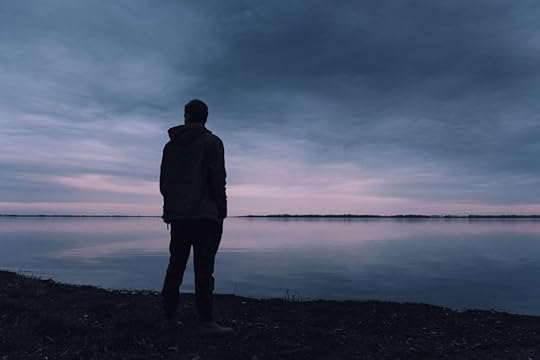
“It was odd when I got there. It was definitely a place where you have a bunch of alpha males. At the time, I wouldn’t have considered myself an alpha male, but I quickly assimilated to what I needed to do. And it was an odd balancing act to be the kid that was caught with a gun, and also a kid that really liked the program, as much as I hated to admit it.”
John liked the competition of the rigorous exercises in the morning. He liked learning to work the forge. “I loved chopping wood, something that I wouldn’t have thought to this day that I would still love to do. It was like therapy.”
A typical day on Penikese for the nine to thirteen students included waking up at 5AM for a run (even if there was a foot of snow on the ground!) or other morning exercises. After breakfast, the students would split into two groups—one group would go to school, and one group would go to work. After lunch, they would swap.
There was no electricity on the island. Running water was on a cistern, a solar panel charged a cell phone and CB radio, and they had a propane fridge. Work for the students consisted of chopping wood, shoveling out the outhouse, putting in the infrastructure for a forthcoming compost toilet, or building an addition for the school. Pigs and chickens needed constant attention.
John is still in touch with one of the teachers from Penikese. He describes Shawn as a “nature guy,” “just an all-around good guy,” who played guitar with him and served as a role model. He remembers another teacher, Omar, as a more “military” type who reinforced the “powers of observation” to his students. Omar would leave Newport Lights around the island and the boys who found the cigarettes received the reward of smoking them.
Once John received his home passes, however, he found himself in trouble once again. As punishment, he was “grounded” to the island for future visits to the mainland.
With only a month or two needed to graduate, John decided he’d had enough. He told the staff to call the boat for him. “I’m done with this,” he said. “Take me to jail, I’m done. I just can’t do it anymore.”
To John’s surprise, they did call the boat.
“I remember sunning myself on the foundation of the addition I’d helped build, waiting for the boat, wondering if they were sending me to adult jail or juvie. You know, I think about it a lot differently now, at forty-one. At the time I couldn’t understand that the length I was there [on the island] was being perpetuated by my own actions. I felt I was missing out on my life. All I remember is this feeling of unfairness.”
Once on the boat, Penikese behind him for the last time, John asked the captain where he was taking him. When the captain answered, “home,” simultaneous feelings of relief (he wasn’t going to jail!) and rage (if it was this easy, why had they kept him on the island for so long?) surged through John.
He had been on the island for one year, and was almost eighteen when the boat brought him home. After returning to the mainland, he worked in a sheet metal shop and attempted to finish high school, but failed gym and science class last semester of his senior year.
Though John never heard much from his father, he remembers receiving a call from him after the failure. “You’re a f’ing idiot,” his father told him.
“But hey, he cared enough to call,” John said, “so in a weird way that gave me the fuel to finish school.”
John jokes that he graduated second in his class of two at summer school. After he graduated, he continued on at the sheet metal shop and worked in HVAC for most of his life.
“Now I build labs. I work for a contractor in Boston. Penikese taught me work ethic lessons I didn’t grasp right away, but as the years went on, they stayed with me. Even as little as seven years ago, I could feel them taking root.”

What were those lessons? That life’s hard, but there’s always a reason to keep going. That hard work is rewarded. Just last year, John’s already decent salary doubled when he was promoted to a managerial position with a company that recognized his strong work ethic.
“It was a long road, but a lot of things I did on Penikese ended up carrying over into the rest of my life. It trickled down,” John said.
John now lives with his wife and four children on 3.5 acres in beautiful New Hampshire. One might still be able to hear the rough-and-tumble kid in the echoes of his voice, but it’s the hardworking man that loves his family and strives to succeed that will stay with me long after our conversation.
While Hope Beyond the Waves is a work of fiction, there’s nothing fictional about John’s life, or the other boys who came to Penikese. Many, like John, are living proof that change can happen—that love and care can plant a seed, that there’s always a reason for hope.
Photo Credit: Warren Wong on Unsplash, Lukas Rychvalsky on Unsplash, and Angela C from Pixabay
Subscribe to my RSS feed

Share this post
From Outcast to Overseer
On the day Hope Beyond the Waves released, I received an Instagram message from a man named John. He congratulated me on the book’s publication and told me he’d been a student at the Penikese Island School in the 1990’s.
My heart gave a small leap. I’d conducted intense research about the island for my novel—not only surrounding the Penikese Island Leper Colony (1905-1921) but surrounding the Penikese Island School, a non-profit private residential school for troubled boys (1973-2011). While I read much about the school and watched documentaries, I was not able to find a student to interview, for obvious privacy reasons.

But now, a student had come to me! Sure, it was after the release of the book, but I couldn’t wait to talk to him. In Hope Beyond the Waves, Emily’s grandmother (whose fictional husband helped start the Penikese Island School in my story) tells her granddaughter that most of the boys attending the island did not turn their lives around. A survey conducted seven years after the island’s opening found that only 16 out of 106 boys had made progress away from crime, drugs, and destruction. An incredibly small number.
I wondered what kind of story I could expect from John.
Within minutes of talking to the now forty-one-year-old, I was put at ease. I liked him immediately. We were the same age. In fact, he’d grown up in my own hometown, although our paths never crossed. He was transparent, down-to-earth, and spoke sweetly to his daughter whose small voice interrupted our conversation to ask if her father might help her find her American Girl doll.
As John spoke of a troubled childhood, my heart ached for the young teen. I sensed rebellion in him, and though John never claimed to be a blameless student, I sympathized with him over the failure of our school systems. I had been a teacher’s aide at a high school years ago—I realized all too well that not all teachers are fair. Many are overworked and overwhelmed.
One day, John’s teacher did not allow him to use the restroom during class—something the teacher had allowed one of the “smart” girls to do. If there was anything John couldn’t stand, it was being treated unjustly. His language and rebellion led to him being kicked out of school, leading to a long line of similar events.
John described himself as “kind of an outcast” and a “hellion.”
“I was on the poorer side, and we used to take cars,” he says. “One of the cars we happened to take had a 38 revolver under the seat.” John hid the gun in his closet. When his mother found it, she called the police.
At this point, John had been kicked out of nine different schools. Because of that, the next step for John was a juvenile detention center. John’s mother asked for the Penikese program instead.
The court agreed.
That was the beginning of a long stay on the smallest of the Elizabeth Islands for sixteen-year-old John.
The program was intended as a six-to-eight-month rehabilitation. John’s stay would be longer.

“It was odd when I got there. It was definitely a place where you have a bunch of alpha males. At the time, I wouldn’t have considered myself an alpha male, but I quickly assimilated to what I needed to do. And it was an odd balancing act to be the kid that was caught with a gun, and also a kid that really liked the program, as much as I hated to admit it.”
John liked the competition of the rigorous exercises in the morning. He liked learning to work the forge. “I loved chopping wood, something that I wouldn’t have thought to this day that I would still love to do. It was like therapy.”
A typical day on Penikese for the nine to thirteen students included waking up at 5AM for a run (even if there was a foot of snow on the ground!) or other morning exercises. After breakfast, the students would split into two groups—one group would go to school, and one group would go to work. After lunch, they would swap.
There was no electricity on the island. Running water was on a cistern, a solar panel charged a cell phone and CB radio, and they had a propane fridge. Work for the students consisted of chopping wood, shoveling out the outhouse, putting in the infrastructure for a forthcoming compost toilet, or building an addition for the school. Pigs and chickens needed constant attention.
John is still in touch with one of the teachers from Penikese. He describes Shawn as a “nature guy,” “just an all-around good guy,” who played guitar with him and served as a role model. He remembers another teacher, Omar, as a more “military” type who reinforced the “powers of observation” to his students. Omar would leave Newport Lights around the island and the boys who found the cigarettes received the reward of smoking them.
Once John received his home passes, however, he found himself in trouble once again. As punishment, he was “grounded” to the island for future visits to the mainland.
With only a month or two needed to graduate, John decided he’d had enough. He told the staff to call the boat for him. “I’m done with this,” he said. “Take me to jail, I’m done. I just can’t do it anymore.”
To John’s surprise, they did call the boat.
“I remember sunning myself on the foundation of the addition I’d helped build, waiting for the boat, wondering if they were sending me to adult jail or juvie. You know, I think about it a lot differently now, at forty-one. At the time I couldn’t understand that the length I was there [on the island] was being perpetuated by my own actions. I felt I was missing out on my life. All I remember is this feeling of unfairness.”
Once on the boat, Penikese behind him for the last time, John asked the captain where he was taking him. When the captain answered, “home,” simultaneous feelings of relief (he wasn’t going to jail!) and rage (if it was this easy, why had they kept him on the island for so long?) surged through John.
He had been on the island for one year, and was almost eighteen when the boat brought him home. He went to work in a sheet metal shop and attempted to finish high school, but failed gym and science class last semester of his senior year.
Though John never heard much from his father, he remembers receiving a call from him after the failure. “You’re a f’ing idiot,” his father told him.
“But hey, he cared enough to call,” John said, “so in a weird way that gave me the fuel to finish school.”
John jokes that he graduated second in his class of two at summer school. After he graduated, he continued on at the sheet metal shop and worked in HVAC for most of his life.
“Now I build labs. I work for a contractor in Boston. Penikese taught me work ethic lessons I didn’t grasp right away, but as the years went on, they stayed with me. Even as little as seven years ago, I could feel them taking root.”

What were those lessons? That life’s hard, but there’s always a reason to keep going. That hard work is rewarded. Just last year, John’s already decent salary doubled when he was promoted to a managerial position with a company that recognized his strong work ethic.
“It was a long road, but a lot of things I did on Penikese ended up carrying over into the rest of my life. It trickled down,” John said.
John now lives with his wife and four children on 3.5 acres in beautiful New Hampshire. One might still be able to hear the rough-and-tumble kid in the echoes of his voice, but it’s the hardworking man that loves his family and strives to succeed that will stay with me long after our conversation.
While Hope Beyond the Waves is a work of fiction, there’s nothing fictional about John’s life, or the other boys who came to Penikese. Many, like John, are living proof that change can happen—that love and care can plant a seed, that there’s always a reason for hope.
Photo Credit: Warren Wong on Unsplash, Lukas Rychvalsky on Unsplash, and Angela C from Pixabay
Subscribe to my RSS feed

Share this post
June 28, 2022
The Real Life History Behind the Penikese Island Leper Colony
I first became fascinated with the history behind Penikese Island when I stumbled upon a book, Island of Hope, by I. Thomas Buckley in 2010. When I learned the island had been home to The Penikese Island Leper Colony in the early 20th century, I was bewildered. Leprosy? In my home state of Massachusetts? In the 20th century? Wasn’t leprosy a thing of biblical stories?
These questions were enough to send me on a research frenzy. I read everything I could, not only about leprosy (Hansen’s Disease) but about the island and the patients. Leaving my toddlers at home with their dad, I ventured up to Boston (a place I had only been to on eighth-grade field trips) to Harvard’s Countway Library of Medicine to read the correspondence to and from the island concerning matters of the patients. I also took a trip to the island with my six-year-old son. A story began brewing in my mind–a story that has not let go of me for more than a decade.
As I learned more about the patients cast off to Penikese for the remainder of their lives, and those who ministered to them, my compassion grew. I wanted to tell their story. While my two main characters (Atta Schaeffer and Dr. Harry Mayhew), are fictional, many of the other characters in the novel are true-to-life people.
I was captivated by Dr. Frank Parker, and his wife, Marion, who ministered to the patients on the island from 1907 until the island’s closing in 1921. At that time, Dr. Parker could not find patients (no one wished to be treated by a man who’d doctored lepers for the last 14 years) and at the age of 66, was refused a pension. I was captivated by the upbeat spirit of the island’s longest resident, Goon Lee Dip (Willie Goon) who remained content despite his hopeless state. My heart broke over the story of Isabelle Barros, who gave birth to a healthy baby boy who was taken from her after only 20 days. I was inspired by Reverend Nathan Bailey, who had been assigned by the New Bedford Ministerial Union to represent all religions as he ministered to the patients. Reverend Bailey became a good friend and confidant of the patients, was not paid for his work, and continued on as the island’s chaplain until the hospital closed in 1921.
This is one of my favorite parts of writing historical fiction–bringing the past to life. Putting my readers (and myself!) in the shoes of those who lived these stories.
In 1973, the Penikese Island School was established as a private rehabilitation school for troubled boys. I was drawn to the fact that this island, in so much of its history, was intended for outcasts. Again, my compassion stirred. I wanted to bring light and hope into these stories. What better way, than a dual timeline novel about loving the unloveable, forgiving the unforgivable, and finding hope in the midst of the impossible?
Below are some pictures I took during my 2011 trip to Penikese.
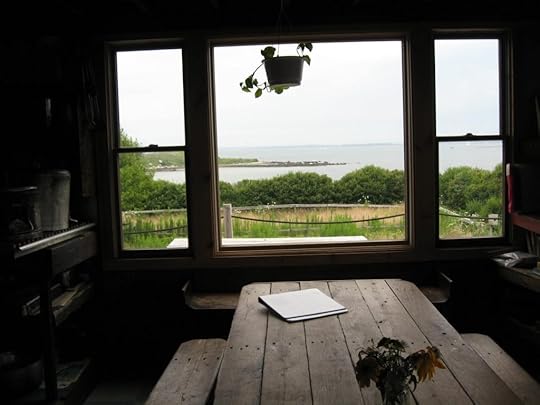 View from inside The Penikese Island School. This was also the site of the administration building when the island served as a Leprosarium.
View from inside The Penikese Island School. This was also the site of the administration building when the island served as a Leprosarium.
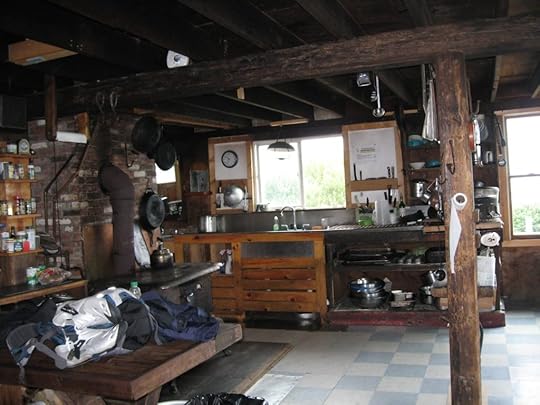 Penikese Island School Kitchen
Penikese Island School Kitchen
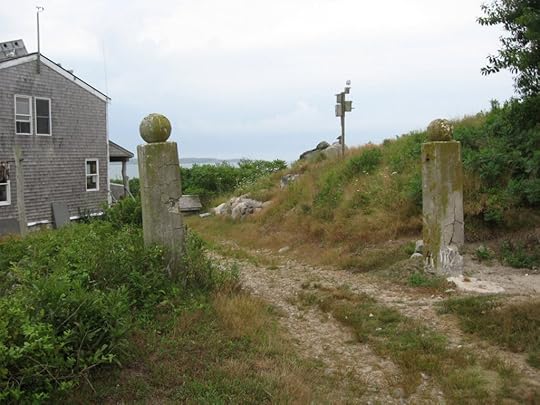 Original columns near the school (what was the administration building). There used to be a bell mounted to one of the columns. The patients would ring it if they needed the doctor’s attention, as they were not allowed to cross to this side of the island for fear of contaminating the side that housed most of the staff.
Original columns near the school (what was the administration building). There used to be a bell mounted to one of the columns. The patients would ring it if they needed the doctor’s attention, as they were not allowed to cross to this side of the island for fear of contaminating the side that housed most of the staff.
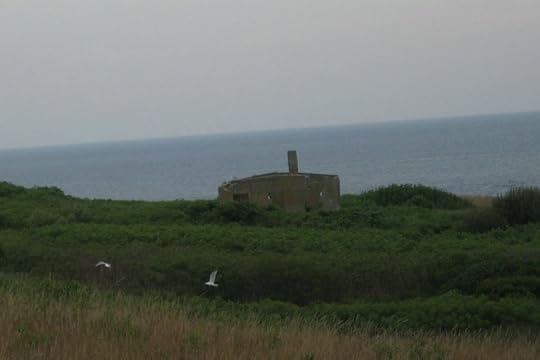 The last of the standing colony, a laundry building on the hospital side of the island. The patients’ clothing was considered highly contagious, so they needed to do their own laundry on “their side” of the island.
The last of the standing colony, a laundry building on the hospital side of the island. The patients’ clothing was considered highly contagious, so they needed to do their own laundry on “their side” of the island.
 Island Cemetery. The monument on the bottom right was erected in 1981 to honor Dr. Frank and Marion Parker.
Island Cemetery. The monument on the bottom right was erected in 1981 to honor Dr. Frank and Marion Parker.
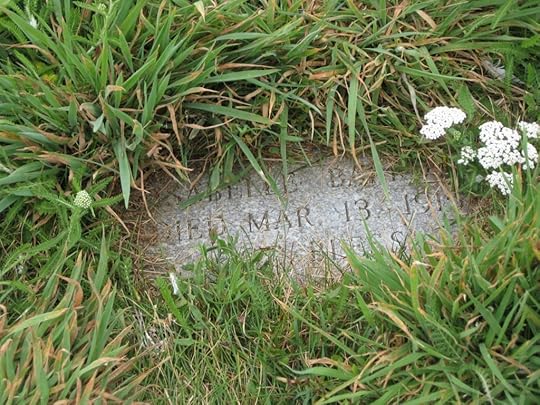 Isabelle Barros was 27 and the only female patient to arrive on the island when it first opened. She was torn away from her husband and two small children, who were placed in a foster home and became wards of the state. She arrived pregnant and gave birth to a healthy baby boy five months later. He was also taken from her. She died 10 years later.
Isabelle Barros was 27 and the only female patient to arrive on the island when it first opened. She was torn away from her husband and two small children, who were placed in a foster home and became wards of the state. She arrived pregnant and gave birth to a healthy baby boy five months later. He was also taken from her. She died 10 years later.
 The only patient to successfully escape the island by rowing thirteen miles to the mainland (he was later apprehended).
The only patient to successfully escape the island by rowing thirteen miles to the mainland (he was later apprehended).
 An old cistern used to collect rainwater.
An old cistern used to collect rainwater.
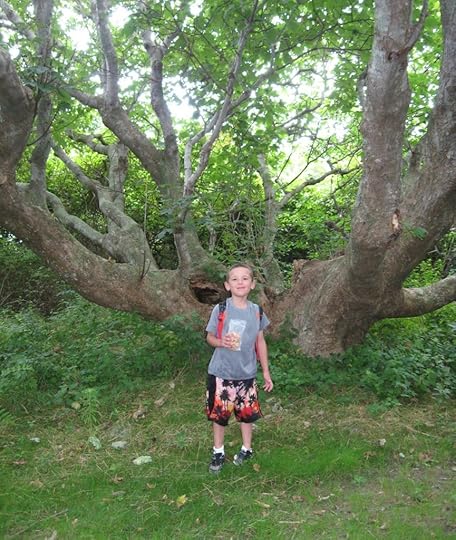 My then-6-year-old (who is now 17 and towering over me!) standing under one of the few trees on the island.
My then-6-year-old (who is now 17 and towering over me!) standing under one of the few trees on the island.
 Heading home!
Heading home!For more pictures and information, visit:
To learn more about my new novel, Hope Beyond the Waves (releasing in just a few days!), visit here.
Subscribe to my RSS feed

Share this post
Release Day for Hope Beyond the Waves!
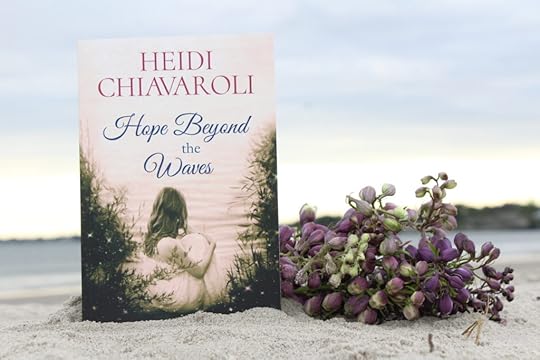
IT’S HERE!
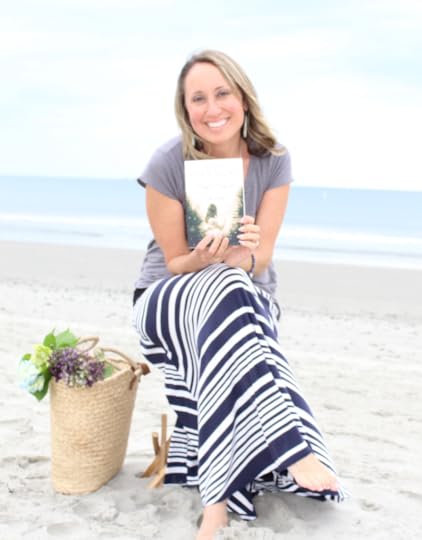
When I turned forty last year, I asked myself what book I would release if I could put out only one more novel in my lifetime. (Lord willing, there will be many more!)
As I conducted my soul-searching, the answer came to me quite clearly. It was a book I began more than ten years ago, a story that has never left my heart. A story about loving the unlovable and forgiving the unforgivable.
Hope Beyond the Waves. (Title courtesy of my newsletter community!)
This past year saw it through some major changes, intensive edits, and more than a few tears. But I can honestly say this is the best it can possibly be. I’ve put every bit of effort, tons of prayers, and any talent my Creator has bestowed upon me into this book.
And now it’s in your hands, and I’m so pleased to present it to you. I hope you enjoy it. I hope the characters and the story touch your heart as they have mine.
Thank you for your support and encouragement. Thank you for reading. Thank you for being an integral part of this amazing journey.
(Click here to read a sample chapter of Hope Beyond the Waves!)
(If you’d like to learn more about the research behind this story and Penikese Island, Massachusetts, visit here.)
Subscribe to my RSS feed

Share this post
June 24, 2022
The Real Life History Behind the Penikese Island Leper Colony
I first became fascinated with the history behind Penikese Island when I stumbled upon a book, Island of Hope, by I. Thomas Buckley in 2010. When I learned the island had been home to The Penikese Island Leper Colony in the early 20th century, I was bewildered. Leprosy? In my home state of Massachusetts? In the 20th century? Wasn’t leprosy a thing of biblical stories?
These questions were enough to send me on a research frenzy. I read everything I could, not only about leprosy (Hansen’s Disease) but about the island and the patients. Leaving my toddlers at home with their dad, I ventured up to Boston (a place I had only been to on eighth-grade field trips) to Harvard’s Countway Library of Medicine to read the correspondence to and from the island concerning matters of the patients. I also took a trip to the island with my six-year-old son. A story began brewing in my mind–a story that has not let go of me for more than a decade.
As I learned more about the patients cast off to Penikese for the remainder of their lives, and those who ministered to them, my compassion grew. I wanted to tell their story. While my two main characters (Atta Schaeffer and Dr. Harry Mayhew), are fictional, many of the other characters in the novel are true-to-life people.
I was captivated by Dr. Frank Parker, and his wife, Marion, who ministered to the patients on the island from 1907 until the island’s closing in 1921. At that time, Dr. Parker could not find patients (no one wished to be treated by a man who’d doctored lepers for the last 14 years) and at the age of 66, was refused a pension. I was captivated by the upbeat spirit of the island’s longest resident, Goon Lee Dip (Willie Goon) who remained content despite his hopeless state. My heart broke over the story of Isabelle Barros, who gave birth to a healthy baby boy who was taken from her after only 20 days. I was inspired by Reverend Nathan Bailey, who had been assigned by the New Bedford Ministerial Union to represent all religions as he ministered to the patients. Reverend Bailey became a good friend and confidant of the patients, was not paid for his work, and continued on as the island’s chaplain until the hospital closed in 1921.
This is one of my favorite parts of writing historical fiction–bringing the past to life. Putting my readers (and myself!) in the shoes of those who lived these stories.
In 1973, the Penikese Island School was established as a private rehabilitation school for troubled boys. I was drawn to the fact that this island, in so much of its history, was intended for outcasts. Again, my compassion stirred. I wanted to bring light and hope into these stories. What better way, than a dual timeline novel about loving the unloveable, forgiving the unforgivable, and finding hope in the midst of the impossible?
Below are some pictures I took during my 2011 trip to Penikese.
 View from inside The Penikese Island School. This was also the site of the administration building when the island served as a Leprosarium.
View from inside The Penikese Island School. This was also the site of the administration building when the island served as a Leprosarium.
 Penikese Island School Kitchen
Penikese Island School Kitchen
 Original columns near the school (what was the administration building). There used to be a bell mounted to one of the columns. The patients would ring it if they needed the doctor’s attention, as they were not allowed to cross to this side of the island for fear of contaminating the side that housed most of the staff.
Original columns near the school (what was the administration building). There used to be a bell mounted to one of the columns. The patients would ring it if they needed the doctor’s attention, as they were not allowed to cross to this side of the island for fear of contaminating the side that housed most of the staff.
 The last of the standing colony, a laundry building on the hospital side of the island. The patients’ clothing was considered highly contagious, so they needed to do their own laundry on “their side” of the island.
The last of the standing colony, a laundry building on the hospital side of the island. The patients’ clothing was considered highly contagious, so they needed to do their own laundry on “their side” of the island.
 Island Cemetery. The monument on the bottom right was erected in 1981 to honor Dr. Frank and Marion Parker.
Island Cemetery. The monument on the bottom right was erected in 1981 to honor Dr. Frank and Marion Parker.
 Isabelle Barros was 27 and the only female patient to arrive on the island when it first opened. She was torn away from her husband and two small children, who were placed in a foster home and became wards of the state. She arrived pregnant and gave birth to a healthy baby boy five months later. He was also taken from her. She died 10 years later.
Isabelle Barros was 27 and the only female patient to arrive on the island when it first opened. She was torn away from her husband and two small children, who were placed in a foster home and became wards of the state. She arrived pregnant and gave birth to a healthy baby boy five months later. He was also taken from her. She died 10 years later.
 The only patient to successfully escape the island by rowing thirteen miles to the mainland (he was later apprehended).
The only patient to successfully escape the island by rowing thirteen miles to the mainland (he was later apprehended).
 An old cistern used to collect rainwater.
An old cistern used to collect rainwater.
 My then-6-year-old (who is now 17 and towering over me!) standing under one of the few trees on the island.
My then-6-year-old (who is now 17 and towering over me!) standing under one of the few trees on the island.
 Heading home!
Heading home!For more pictures and information, visit:
To learn more about my new novel, Hope Beyond the Waves (releasing in just a few days!), visit here.
Subscribe to my RSS feed

Share this post
June 21, 2022
One More Week Until Hope Beyond the Waves Releases!
Eight years ago, I flew to St. Louis for the ACFW Awards Gala. The airline lost my luggage, and I almost wore too-big Birkenstocks and khaki pants borrowed from a sweet friend to the fancy dinner. Miracle of miracles, my luggage came to the hotel TEN minutes before the ceremony began. Not long after, I was honored to accept the Genesis Award (a contest for unpublished writers) in the Historical Category for my manuscript, Tears of the Outcast.
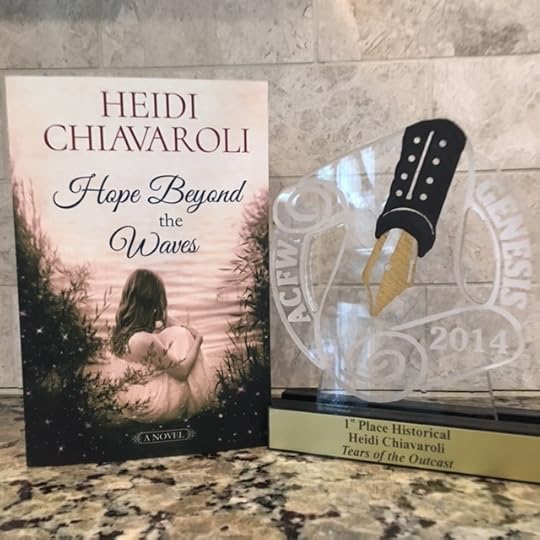 Finally making its way to readers (under a different title)!
Finally making its way to readers (under a different title)!That contest win helped me obtain an A-list agent, and although the book that won the contest didn’t receive a publishing contract, the next book I wrote, Freedom’s Ring, landed a contract with my dream publishing house.
This month marks the release of my TENTH novel, which happens to be the novel that won the Genesis all those years ago (now titled Hope Beyond the Waves thanks to the generous input of my newsletter peeps!). As I received the paperback books this week and held them in my hands, a knowing settled over me that God didn’t have to write this story for me–He did it out of His immense grace. This is the book of my heart, and as I created it, my Creator has taught me tons of patience through it. I can’t wait to hear what you think of Hope Beyond the Waves, releasing in ONE WEEK!
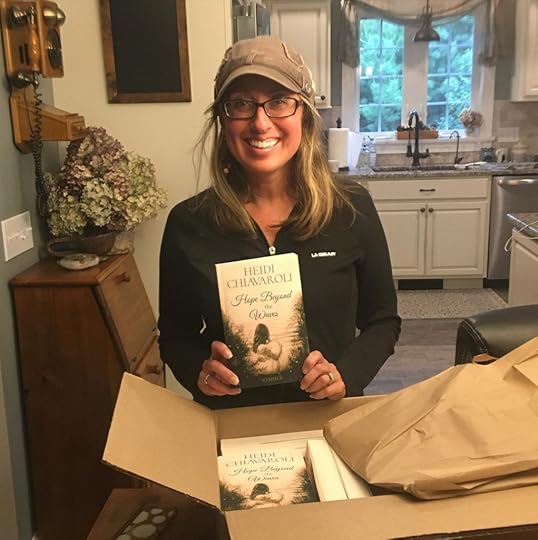 The arrival of paperback books!
The arrival of paperback books! Hope Beyond the Waves is available for preorder and will officially release next Tuesday, June 28th!
Subscribe to my RSS feed

Share this post
February 25, 2022
A Terrifying Swim
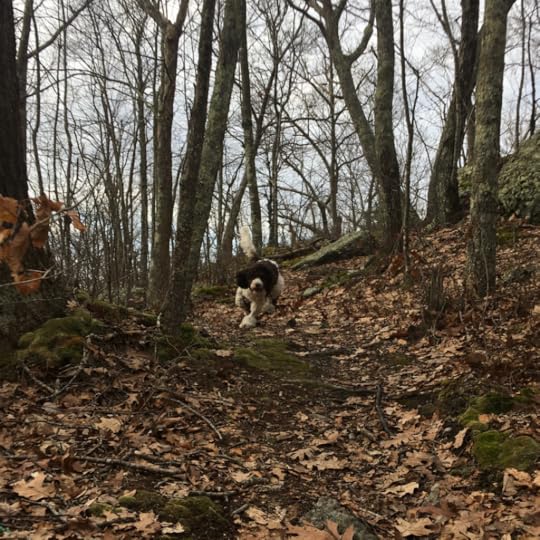
This picture was taken yesterday morning, just twenty minutes before the most terrifying experience I’ve ever had in the woods.
Despite the 20-degree weather, Wyatt and I began our hike early yesterday to enjoy the quiet (less people before 8AM). The ground was clear of snow and I decided to run with him. It was beautiful. An hour and a half later, we headed back toward the car.
There’s a large body of water leading to the town’s dam. We’ve gone kayaking on it before. Just four days ago, men were ice fishing. The ice had recently melted, but when Wyatt went down to the bank, I didn’t think much of it. He hasn’t tried to go into he water since summer and he always (well, 99% of the time), comes when I call him. He likes to look at the geese and run along the bank to follow them.
But this time, two beautiful white swans were just out of reach. He started wading in. I called him, using my most stern voice. Nothing. Now he was swimming toward the swan. I still didn’t think he’d go far—I was more concerned the swan would get angry and attack him.
I couldn’t believe how fast he followed the swan to the middle of the reservoir, despite my frantic screaming and tears. I sounded like a lunatic. The water was FREEZING and he’d never even swam before. But suddenly, he was paddling in the middle of the river, and I thought for sure he’d die of hypothermia and I’d have to watch him go under while I stood helpless on the bank.
I called my husband as I ran up the bank closer to my dog, who encouraged me to call 911. They in turn connected me to the fire department and I explained what had happened even as I doubted they could do anything to help me.
By now, Wyatt had traveled near a 1/4 of a mile and was closer to the other side of the river. I prayed aloud, frantic, calling him between pleas that God would somehow protect my stupid dog, still paddling mindlessly after that swan, his little black head a small blob beside the pure white of the two swans.
I reached a far bank, waved my hands and called. Nothing. I ran back the other way and met the fire chief, who spoke to me in a calm, kind way and urged me not to call him because another crew was going to the other side of the reservoir with a boat.
We watched as Wyatt kept up his rebellious swim. How could he have enough energy to even make it back to shore? He was still recovering from Lyme disease. We’d run hard in the woods. Would his little heart suddenly give out from the freezing temperatures? I thought of my youngest son, Noah, and wondered if he’d ever be able to forgive me if I came home without our pup. I cried more, prayed more.
Wyatt’s paddling seemed less vigorous now. He looked toward me, and for the first time since he entered the water, seemed to remember my existence.
“I think we’ve got his attention now,” the fire chief said, directing me to run up the river so I could be closer to him.
I don’t think I’ve run so fast since high school. Tearing through the brush, I reached the wooded bank as I continued calling. Finally, he came closer, not looking well at all, but still swimming slowly. I grabbed his collar, still certain he was going to just collapse. I helped him up the bank where he did indeed collapse on my lap, shivering and shaking up a storm, soaking my clothes through.
The fire chief gave me a blanket for him and a ride back to my car. I thanked him profusely. (How amazing are our first responders?!) We called the vet, who said to watch him but because poodles are water dogs (oh, really???), that he should be fine. I later looked at the call time between when I first called my husband and when I finally got Wyatt out of the water. Twenty minutes.
We got him home and gave him a warm bath. He stopped shivering far sooner than I expected. As I was drying him off with the hairdryer, he tried to eat a sock I’d discarded as I’d coaxed him in the tub (rather, sat in the tub with him fully clothed). He was fine! While he’d took at least a month off my life, he hadn’t a care in the world. Just an everyday swan chase in the freezing reservoir.
Sometimes I kick myself for loving a dog this much. A dog who doesn’t care a flip for my emotions and most likely doesn’t understand them. But then he comes and puts a paw on my lap, asking for a cuddle. (Despite his 55 pounds, he still likes to sit in my lap.) And I know. All the grief, all the work of feeding and cleaning and taking care of him…all the stress he caused me by chasing after a bird, it’s all worth it.
Subscribe to my RSS feed

Share this post
February 11, 2022
My 84-Hour Fasting Experiment
Disclaimer: This has nothing to do about my books or writing in any way. It’s a life post. Feel free to skip if you just want to read fiction. 😉
The Why of My Fasting Experiment:
Some of you know I’m a bit of a sideline health nut. Most of this stems from my struggle with autoimmune issues over the last few years. After falling into a bit of an eat-whatever-I-please-including-plenty-of-sugar pit last December and then coming down with Covid, I wanted to give my body the best opportunity to heal.
While reading a health book my mother had passed onto me, the author claimed that one of the best ways to detox one’s body was fasting. This was a completely new concept to me. While I often practice Intermittent Fasting to rest my digestive system (fasting for say 16-20 hours at a time, which for me means eating lunch, going to work for a Walmart shift from 2-7, and not eating until later the next morning) and have fasted for spiritual purposes for that same amount of time, I had never considered fasting for longer.
 Pixabay
PixabayI was intrigued, so I dug into two fasting books, completed a forty-hour juice fast, and then decided to tackle a longer fast. The idea, so the science says, is that once your body stops burning sugar (glycogen), it will burn fat, getting rid of a lot of the stored “junk” in our bodies. There’s even a study out of MIT that claims fasting boosts the regenerative capacity of stem cells. Insulin goes down and human growth hormone (HGH) go up–a good thing considering some of the effects of aging seem to stem from low HGH (the height of which occurs during puberty).
Okay, that was a lot of science, but it got me excited. As does the fact that fasting has so many spiritual roots. (Let me just say, after my pitiful 84-hour fast, I have an entirely different newfound respect for Jesus’s 40-day fast in the desert!) I have a lot more to learn, but I love the learning. And the reading. Lots of reading! But armed with a little bit of knowledge, I decided to embark on my first long fast. My goal was five days, but as we’ll see, that was a bit unrealistic, for me, at least….
ANOTHER DISCLAIMER: I am not a health professional and it is advised that you speak with your doctor before beginning a longer fast, especially if you have medical conditions.
Another Note: My fast included LOTS of water, a cup of bone broth every day, lemon water, herbal tea, and water with Vitamin C powder. I still took my thyroid medication in the morning and my multi-vitamin after Day 1.
Day 1: I was actually surprised how cranky I was on Day 1. I think if I had eaten better the day before my fast (I splurged on some dairy and chocolate–things I usually try to stay away from), day 1 would have been easier. I was obviously hungry and my stomach kept growling. But I slept great!
Day 2: Mood much better! Still quite hungry, but the funny thing about hunger is that it doesn’t actually get worse. Yes, my stomach was still growling, but I couldn’t honestly say I felt any hungrier than I did the day before. I still had plenty of energy. When the family sat down to dinner, I enjoyed a cup of bone broth. My legs ached for no apparent reason, but I read this could happen, so I took a magnesium supplement.
Day 3: Almost exactly 48 hours into the fast, I noticed a dramatic shift. I’m guessing this is when my body completely ran out of glycogen and the heavy duty cleanup of fasting began. I felt nauseous and tired. When I woke on Day 3, I told myself I would not go past 3 1/2 days if I didn’t start feeling better. Though I did get a burst of energy mid-morning after some lemon water, it was short-lived. I stand up to write and I couldn’t even do that. My legs ached. About midday, I finally allowed myself to lay down. I napped for two whole hours! I awoke still nauseous and achy.
Looking back, I wonder if some of this was due to my mild hypothyroidism. I did not consult with my primary care doctor or my functional doctor before starting the fast, and I intend to before trying this again. Then again, it might have just been my body’s very real reaction to no food!
Funny, but at this point I wasn’t even hungry–just nauseous. And yet, I still very much wanted food because I assumed it would make me feel better (of course). I went to bed knowing I would break my fast the next morning. My sleep was horrible. I was jittery (was it the anticipation of food the next morning?) and my legs ached horribly. I awoke the next morning still feeling lousy and eager to put an end to the fast.
Breaking the Fast:
I had planned (and even dreamed) about what I would eat on this first day. I knew I needed to go slow–I didn’t want to shock my body or overeat and ruin any hard work I’d accomplished. I started with a 1/4 cup of pumpkin seeds and walnuts with herbal tea. I don’t think anything has ever tasted so good as these unsalted morsels! I chewed super carefully and simply SAVORED the beauty of God’s gift of food. Wow. Within ten minutes, my nausea disappeared. I made myself wait another hour before eating an apple and walnut butter. I didn’t have what I consider a full meal of cooked kale, bacon, onions, and dairy-free cream cheese until an hour after that. By this time, all my aches disappeared and I felt PHENOMENAL. All my energy returned much quicker than I expected. I happily fluttered around the kitchen the rest of the morning making hummus and chicken broth and grain-free bread.
I was careful not to overeat this first day and relished every single solitary bite. An overwhelming feeling of contentment and gratitude that didn’t go away for at least three days after I ended my fast settled over me. I also had no desire for sugar during this time.
What I’d Do Differently
Eat better leading up to the fast. I think giving my liver a head’s up is only fair. I should have practiced completely clean eating at least a week or two before my fast.
Talk to my doctor about side effects/dangers of fasting with Hashimoto’s.
Focused more on the spiritual aspect of fasting. While I have done this a lot in the past, I was so focused on the benefits for my body I’m ashamed to admit I missed out on the spiritual benefits I know were there for me. While I still prayed and meditated, I didn’t make it a habit of seeking God through the hunger. So I’d definitely make a more conscious effort to do this differently!
Have you ever done a longer fast? I’d love to hear about your experiences!
Subscribe to my RSS feed

Share this post



